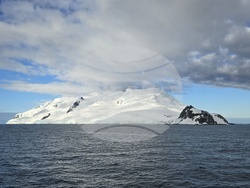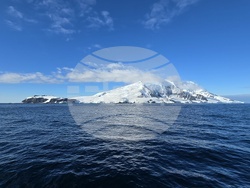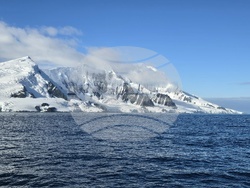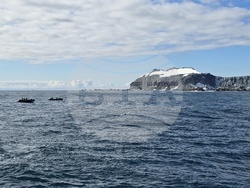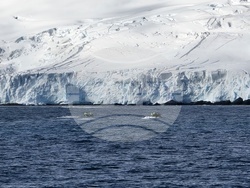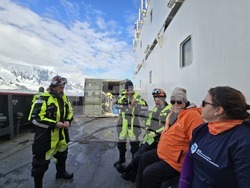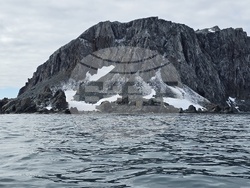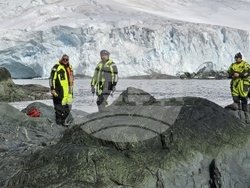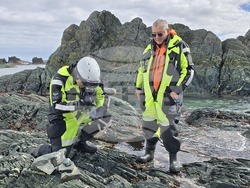site.btaAntarctic Institute Head Pimpirev: We Laid Foundations of First Bulgarian Geological Research on Smith Island


Prof. Christo Pimpirev, head of the Bulgarian Antarctic Institute, scientists from the Bulgarian Antarctic Expedition, logisticians, and members of the crew of Bulgaria's naval research ship Sv. Sv. Kiril i Metodii (RSV 421) Wednesday visited and surveyed Smith Island, the most remote island of the South Shetland Islands archipelago. Prof. Pimpirev told BTA's special correspondent Milena Ostrovska that Smith Island is the most inaccessible of all the islands in the archipelago and that thus far, there have been only three known expeditions, two of them commercial, to climb the island's highest peak (2500 m), which is also the highest in the archipelago.
The visit to Smith Island is not an end in itself, said the geologist. "Here we laid the foundations for the first Bulgarian geological research on the island, as it has a unique geological history. Its rocks have no analogue anywhere else in the whole of the South Shetlands, they are formed at a very great depth of 50-60 kilometres below the earth's crust, so there are no serious publications so far on the geology of this region," he explained.
Three samples, each weighing 5 to 6 kg, were taken from the island for analyses of different rock types. According to Prof. Pimpirev, this will shed light on the history of the island's development. The approximately 15 kg of samples were collected from different locations, and he hopes to have a research project in the near future. He thinks that once the area has been explored and it has been established where there is an outcrop of rocks, a field camp can be made, because at least one month of field work needs to be done. He thinks a lot of interesting results will come out of Smith Island that have not been published at all; geologists just have not come to study the geology.
"This is a pioneering visit and exploration of Smith Island! Of course, fate has helped us: the weather has been great, which is very rare. Our ship is almost in open water. The island is the furthest from all the other islands and is in the ocean. It is constantly being pounded by strong waves. It is quite adrenaline-filled getting off the ship and onto the boats, so there is action!" Prof. Pimpirev summarized.
RSV 421 approached the southeastern part of Smith Island as early as around 5 a.m. on Wednesday. "We started surveying and exploring at a distance of about 2,000 to 2,500 metres, and this gave us further information that at this distance from the island we have sufficient depths safe for navigation. There was good visibility: sunny weather, clear with winds below 2-3 m/s. We approached from the northeast and were able to look specifically at Cape Smith, which is a huge rock outcrop and is of great scientific interest, from the point of view of geology and especially of our expedition," said RSV 421 Commanding Officer Radko Muevski.
A survey was made from the ship of specific locations allowing to go ashore in this area. One possibility was judged to be more difficult to access in its last part: the disembarkation. The second location was discovered by a drone flyover of the area. Captain Muevski explained that this, in addition to a much quicker view of the terrain, allowed for quick decision-making and saved time and resources. He clarified that he had chosen this bay, which was close to the rock outcrop - quiet in terms of the swell and easy to access and approach with the ship, at a distance where it would be audible on the radios and if a boat needed to return, it would happen quickly. The Zodiac boats were launched about three kilometres from the bay with a group of scientists and logisticians. He explained that Smith Island is the westernmost of the entire group of islands in the South Shetland archipelago. Its west coast is fully exposed to the influence of both the Southern Ocean and the Pacific Ocean, and these conditions and any cyclones that form immediately along this path suggest careful monitoring of the hydrometeorological situation for suitable opportunity to launch boats.
"We were able to go ashore, take samples and record this as a first survey in the history of our expedition. Accordingly, everyone [managed] to return safely within about two and a half hours, that was the stay ashore, which is quite normal," added the naval research ship's Commanding Officer.
The Bulgarian naval research vessel Sv. Sv. Kiril i Metodii (RSV 421) departed from Varna on its third Antarctic expedition on November 7, 2024, and arrived at Livingston Island on December 28. The St Kliment Ohridski Bulgarian Antarctic Base on Livingston Island opened for the new polar season on November 23, 2024.
BTA has a national press club on the vessel and at the Bulgarian Antarctic base. This is the third year in a row that BTA has sent a correspondent to Antarctica. This year's correspondent is Milena Ostrovska, who arrived at the base on January 17. Her reports are available for free in English at the Bulgaria-Antarctica Log on BTA's website and can be used for free by all media with attribution to BTA.
/DS/
Additional
news.modal.image.header
news.modal.image.text
news.modal.download.header
news.modal.download.text
news.modal.header
news.modal.text


